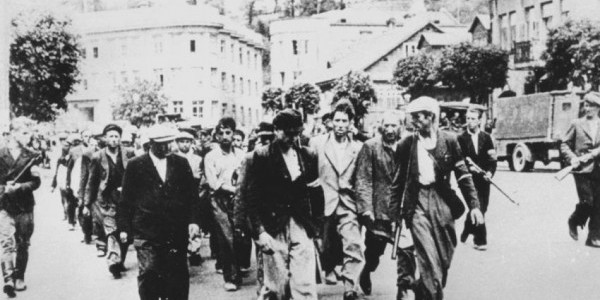Lithuanian Militia Men Leading Jews to the Seventh Fort, Kovno, Lithuania, 25 June 1941
25/06/2020 | Na stronie od 25/06/2020

Antisemitic Lithuanians in Kovno went on wild killing sprees directed against the Jews during the first days of the Nazi invasion. Thousands of Jews were transferred to locations outside the city, including the Seventh Fort, which was one of a chain of forts built around Kovno during the nineteenth century. The Jews brought there were brutally abused and then shot by Lithuanians and Germans. In all, some 10,000 Jews were murdered within the first six weeks of the German invasion.
Kovno was an important spiritual and cultural center of Eastern European Jewry. It boasted the renowned Yeshiva in Slobodka, and a Jewish educational network ranging from kindergartens to teachers' colleges, as well as being an active Zionist hub.
After World War I, Kovno became the capital of Independent Lithuania. In 1940, Kovno was annexed to the Soviet Union, together with its approximately 40,000 Jews. The Soviet regime closed the Jewish schools and most of the cultural and social organizations.
With the German invasion of the Soviet Union on 22 June 1941, before the occupation of Kovno, Lithuanians embarked on wild killing sprees directed against the Jews. On 24 June, the Germans occupied Kovno, and the murders continued under their direction. In late June and early July, some 10,000 Jewish men, women and children were arrested. They were taken to sites such as the Fourth, Seventh and Ninth Fort, which constituted part of a series of forts built around Kovno in the nineteenth century. In the Seventh Fort, the men were separated from the women and children, and kept in the open air. The Lithuanian guards abused them and shot at them randomly.
On 6 July, the Lithuanians shot the thousands of men still alive at the Seventh Fort. By the end of July, some 10,000 Jews had been murdered there.
The Germans confined the remaining 30,000 Jews of Kovno in a ghetto, which was sealed in August 1941. The mass murder of Kovno Jewrey recommenced in mid-August. Within less than three months, some 3000 Jews were taken out of the ghetto and murdered. By the end of 1941, another 14,000 Jews from the ghetto were murdered in the Ninth Fort, about half of them children. Most of them were murdered on one day at the end of October, after a selection in the ghetto. At the end of 1941, another 20,000 Jews brought to Kovno from the German Reich (parts of Germany, Austria and Western Poland) were murdered in the Ninth Fort, after which the killings were halted until March 1944. There were still some 17,000 Jews in the Kovno ghetto. In the fall of 1943, the ghetto became a concentration camp, and some 6,000 Jews were transferred from there to adjacent small camps. In March 1944, some 1,800 babies, children and elderly Jews were taken out of the ghetto and murdered in the Ninth Fort.
In July 1944, the Red Army drew close to Kovno. Before their retreat, the Germans deported thousands of remaining Jews to concentration camps west of Kovno, systematically burned the ghetto down house by house, and murdered some 2000 Jews who had tried to hide within the ghetto. When the Red Army entered on 1 August 1944, they found 90 Jews who had managed to survive in hiding on the grounds of the former ghetto. In total, out of 40,000 Kovno Jews, less than 2,500 survived the Holocaust. In the early 1990s, monuments were established on the sites of the Fourth, Seventh and Ninth Fort in memory of the mass murder of the Jews at the hands of the Nazis and their local collaborators.
For more information on the Jews of Kovno during the Holocaust, click here
Yad Vashem Photo Archives 2725/17